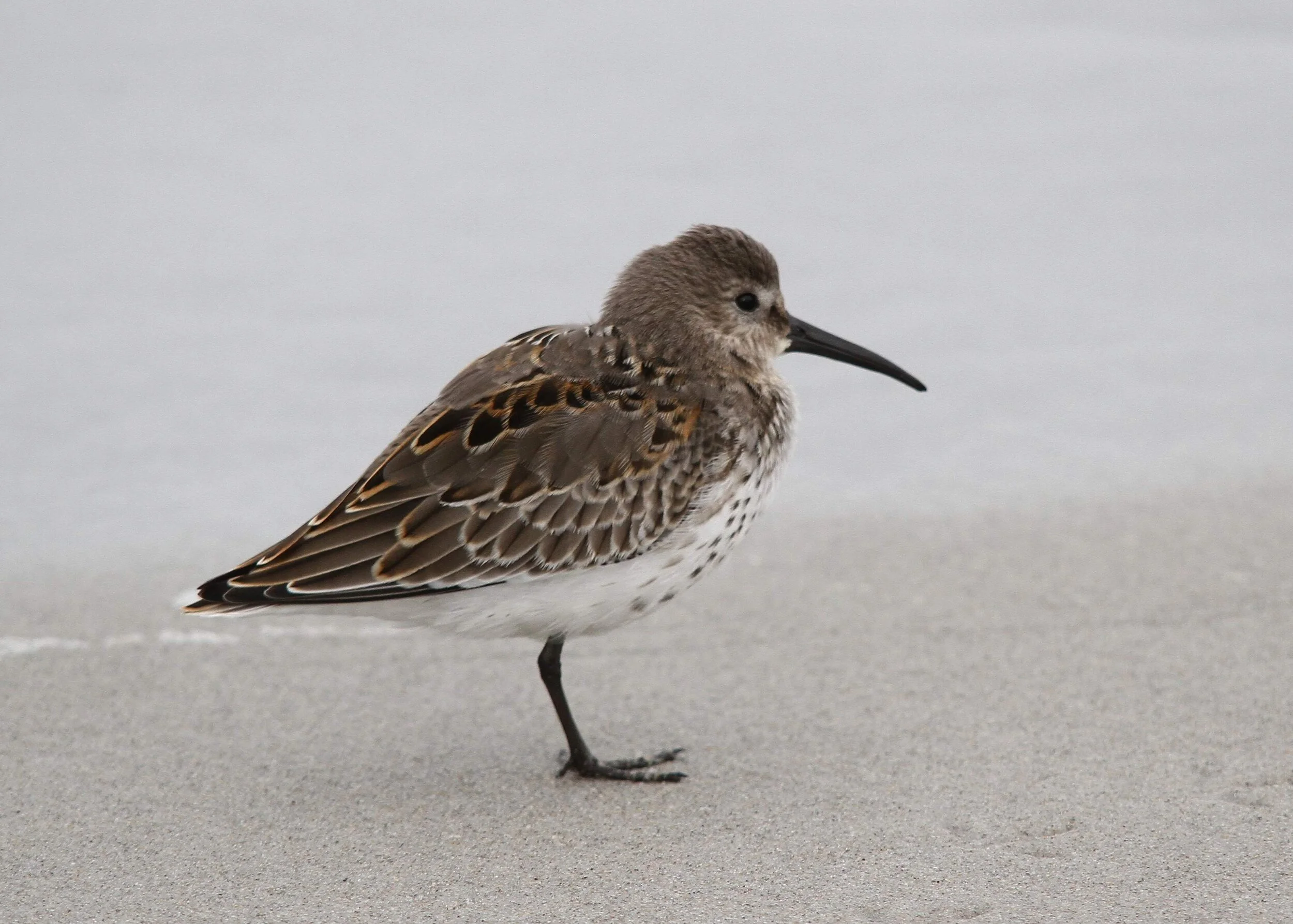First year Hudsonian Dunlin
Post originally published in Birding Frontiers
Hudsonian Dunlin records have been claimed several times in the UK & other countries in Europe, usually adults in mostly summer plumage in late spring and summer, when the pale head and bright back of Hudsonian is quite different from European birds (but, on the other hand, is difficult to separate from several Pacific taxa). However, Hudsonian Dunlin also differs from Dunlins that occur regularly in Europe (including several taxa, with the majority alpina) in juvenile/first-winter plumage, when the likelihood of a vagrant is perhaps higher. Dunlins arrive in good numbers to the east coast of the United States in late September, only slightly later than Baird's Sandpiper and American Golden Plover.
After careful study of a few hundred first-winter birds, I think some of the features typically shown by Hudsonian are actually quite rare in European birds, and their combination on a prototypical individual should confidently indicate a nearctic origin.
Moult: probably the most obvious difference at first glance is that the birds arrive in September from the breeding grounds already in a remarkably advanced moult. Most birds have moulted head, breast, and most of the back feathers; the belly, rump and wing coverts are usually moulted slightly later. For instance, all 9 first-year birds seen [in Massachusetts or on wintering grounds?] on September 24th were in moulted plumage; only one out of 76 was still in mainly juvenile plumage on October 1st; and only 3 out of 54 seen on October 8th showed partially (but still fairly advanced) juvenile plumage. Thus, the proportion of birds arriving with retained juvenile plumage may be well below 5%. At this time of year, most first-year Dunlins in Europe will have some replaced scapulars, but not most of them, and rarely if ever show a complete winter plumage overall. In contrast, many Hudsonian Dunlins leave some back and rump feathers unmoulted until the late autumn and winter, and show a characteristic line of conspicuous rufous-fringed scapulars contrasting with the moulted grayer feathers, looking similar to [breeding plumage] Western Sandpiper.
Bill shape: Hudsonian Dunlins on the East Coast present limited variability in bill shape and length, at least compared to Dunlin taxa in other parts of the world. Most Hudsonians have a very long bill, which curves down at the end, somewhat similar to Curlew Sandpiper. Some birds also show a broad 'drop' at the bill tip. Even in the shortest-billed birds the bill shape is characteristic, and considerably different from the majority of Dunlins in Europe (although, obviously, some European birds do show similar bills).
First-year Hudsonian Dunlin, October 2016, Massachusetts (USA). Guillermo Rodríguez
Facial pattern: many Hudsonians present a characteristic facial expression: the brow is usually broad, and ends sharply just beyond the eye; in some birds there is a conspicuous pale area in front of the eye. The cap and nape are roughly concolorous, and thus more contrasting with the supercilium. In European Dunlins, the nape tends to be paler and so the supercilium seems to “merge” with it, contrasting with a slightly darker cap. As a useful comparison, these differences are reminiscent of the differences in facial pattern between Western and Semipalmated Sandpipers (with Hudsonian being more similar to Western.).
First-year Hudsonian Dunlin, October 2016, Massachusetts (USA). Guillermo Rodríguez
Breast and belly patterning: this feature has been considered as diagnostic in the past. Once they have moulted into winter plumage (but not in juvenile plumage!), around 60-70% of birds present short streaks on the flanks of the underparts, beginning at the belly and sometimes reaching as far as the undertail. In some of these birds, the dirty grey patch on the breast partially extends towards the belly along the flanks. In most European birds, the underparts are neatly white, but some exceptional birds showing a similar spotted pattern to Hudsonian have been recorded (see below).
Some examples illustrating the variability of first-winter Hudsonian Dunlins. All pictures show first-winter birds in late September/ early October 2016, Massachusetts (GR).
First-year Hudsonian Dunlin, October 2016, Massachusetts (USA). Guillermo Rodríguez
First-year Hudsonian Dunlin, October 2016, Massachusetts (USA). Guillermo Rodríguez
First-year Hudsonian Dunlin, October 2016, Massachusetts (USA). Guillermo Rodríguez
First-year Hudsonian Dunlin, November 2015, Massachusetts (USA). Guillermo Rodríguez
Edit: on September 2nd, 2017 I was lucky to find a (mostly) juvenile-plumaged Hudsonian Dunlin in Cape Cod, Massachusetts. Not much to say about the plumage, but interesting to see how they look like!
First-year Hudsonian Dunlin, September 2017, Massachusetts (USA). Guillermo Rodríguez







